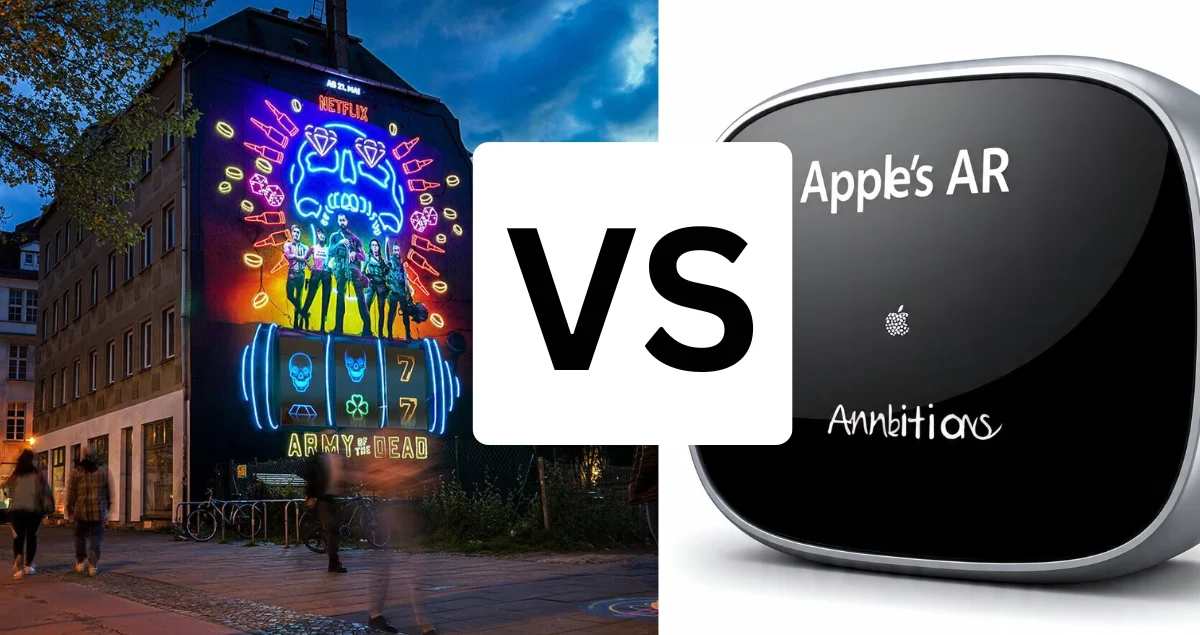Netflix's Ad Army vs. Apple's AR Ambitions: Divergent Paths to Dominance
Introduction
Netflix’s ad army and Apple’s AR objectives are two distinct methods to get to the top.
Netflix and Apple are both trying to get our attention and money, but they are doing it in very different ways. Apple is quietly constructing the future with AR content, while Netflix is winning the present with its big ad blitz. Let’s take a deeper look at this interesting strategy battle.
Netflix: The Ad Giant
- The Play: Use its vast global audience and library of material to provide a lower-priced subscription level that is financed by ads.
- The Win: Things are going well. Netflix’s ad-tier plan had more than 40 million active customers throughout the world per month as of mid-2024. The plan is the company’s fastest-growing one. This plan draws back users who care about price and subscribers who left because prices went up.
- Expands the Funnel: Makes it easier for people on a budget to get in.
- Unlocks Huge Ad Revenue: It gives marketers who want to reach high-end customers a new, high-margin way to make money without cookies.
- Works well with Password Crackdown: provides those who share accounts a genuine, cheap choice.
- Dominance: Netflix is swiftly becoming a key player in the streaming ad sector, going up against well-known sites like YouTube and normal TV.
Apple: Investing in AR's Future
- The Play: Use the high-end Vision Pro headset to get exclusive, high-quality AR/VR content that will help the future of spatial computing.
- The Win (Potential): Apple doesn’t want a lot of people to use its devices right away or make a lot of money from marketing. It’s:
- Setting a high standard for AR by creating fun experiences that show what it can be, such as immersive movies, 3D sports, and interactive environments.
- Building an Ecosystem Early: Getting developers and creators to produce items for the platform before it becomes popular.
- Owning the Premium Future: Becoming the leader in the next conceivable computer platform, where the way people utilize things could alter a lot.
- The Problem: Vision Pro costs a lot of money and is only for a few people. It’s hard and costs a lot of money to make content. It will probably be years, if not decades, before immersive AR and VR become popular forms of entertainment.
The Difference
Timeframe: Right now, Netflix is the biggest name in streaming. Apple is getting ready for the spatial experience of tomorrow (or the day after tomorrow).
Monetization: Netflix’s ad tier is now a straightforward, scalable, and high-volume way to make money. Apple’s AR content is a sensible approach to investing in the platform’s value and future lock-in, with hardware sales and app store cuts later as indirect ways to make money.
Audience Reach: Netflix’s ad tier extends to hundreds of millions of users. Apple’s high-end AR is meant for thousands (maybe millions soon) of rich people who want to be the first to use it.
Netflix includes a lot of classic television that you may watch whenever you want. Apple = new experiences that are immersive, interactive, and spatial.
Conclusion
Right now, Netflix is winning. Its ad-tier strategy is a great method to make money from the streaming industry today, given its size and content. It’s a business model that works and grows swiftly.
Apple is in it for the long haul, and its focus on AR is both visionary and hazardous. Spatial computing needs to be utilized by a lot of people in order to be successful, but it’s not clear when that will happen or how much progress will be made in technology.
Directly comparing them is like comparing apples and oranges. Netflix dominates the subscription streaming industry, standing as the clear leader. Meanwhile, Apple aims to carve out and lead an entirely new frontier.
Complementary strategies: Ultimately, both approaches can coexist and even converge. Future AR and VR headsets will likely support streaming services like Netflix. In the future, Netflix might attempt immersive entertainment genres.
fAQ's:Netflix's Ad Army vs. Apple's AR Ambitions
Is the Netflix ad tier really that popular?
Yes. Getting more than 40 million MAUs so quickly is a big deal that shows the approach works. It’s one of the most important things that helps Netflix grow.
Will Apple's strategy for AR content work?
It’s too early to say for sure. while it depends on how many people start using Vision Pro (and other, cheaper headsets in the future) and how much Apple and developers can generate content that makes the platform worthwhile. It’s a risky play with a big payoff.
Why isn't Apple launching a TV+ ad tier?
Apple cares more about the quality of its brand experience, user privacy, and how well its hardware and services work together than it does about attracting more TV+ members or ad revenue. Its ecosystem profit model is different.
Which plan is preferable for people who want to invest?
Netflix offers growth and stability in the near future. There is a lot of uncertainty about Apple’s future, but it has a lot of potential. It all depends on how much risk you’re willing to take and how long you want to invest.
Will Netflix ever produce things for AR and VR?
Maybe, but only if a lot of people watch. They’ve made interactive content like Bandersnatch, but their main focus is still on their core streaming platform. They’ll go with the flow.
Can Apple catch up to Netflix in regular streaming?
Not likely as a key goal. Apple TV+ doesn’t strive to get as many users or as much content as Netflix. Instead, it focuses on high-quality, award-winning content to make its ecosystem more useful.
I’m Saima Gulzar — blending fashion, mindful self-growth and modern femininity into stories that uplift and empower. My work is about discovering elegance in everyday living and embracing the journey of becoming.


